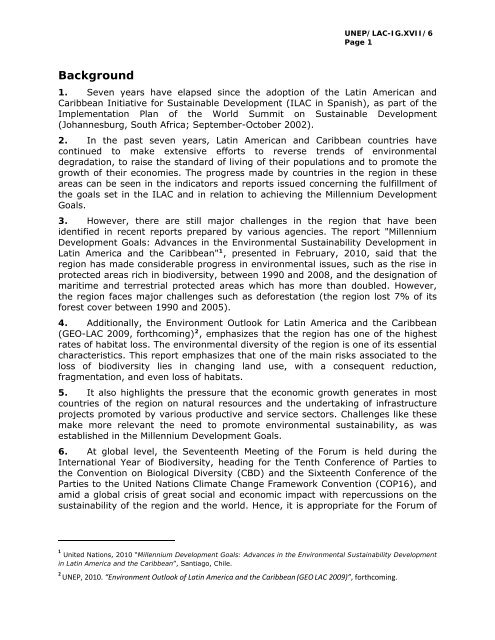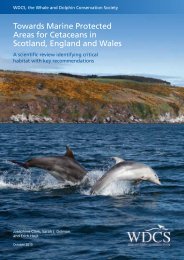English - Programa de Naciones Unidas para el Medio Ambiente
English - Programa de Naciones Unidas para el Medio Ambiente
English - Programa de Naciones Unidas para el Medio Ambiente
- No tags were found...
You also want an ePaper? Increase the reach of your titles
YUMPU automatically turns print PDFs into web optimized ePapers that Google loves.
UNEP/LAC-IG.XVII/6Page 1Background1. Seven years have <strong>el</strong>apsed since the adoption of the Latin American andCaribbean Initiative for Sustainable Dev<strong>el</strong>opment (ILAC in Spanish), as part of theImplementation Plan of the World Summit on Sustainable Dev<strong>el</strong>opment(Johannesburg, South Africa; September-October 2002).2. In the past seven years, Latin American and Caribbean countries havecontinued to make extensive efforts to reverse trends of environmental<strong>de</strong>gradation, to raise the standard of living of their populations and to promote thegrowth of their economies. The progress ma<strong>de</strong> by countries in the region in theseareas can be seen in the indicators and reports issued concerning the fulfillment ofthe goals set in the ILAC and in r<strong>el</strong>ation to achieving the Millennium Dev<strong>el</strong>opmentGoals.3. However, there are still major challenges in the region that have beeni<strong>de</strong>ntified in recent reports prepared by various agencies. The report "MillenniumDev<strong>el</strong>opment Goals: Advances in the Environmental Sustainability Dev<strong>el</strong>opment inLatin America and the Caribbean" 1 , presented in February, 2010, said that theregion has ma<strong>de</strong> consi<strong>de</strong>rable progress in environmental issues, such as the rise inprotected areas rich in biodiversity, between 1990 and 2008, and the <strong>de</strong>signation ofmaritime and terrestrial protected areas which has more than doubled. However,the region faces major challenges such as <strong>de</strong>forestation (the region lost 7% of itsforest cover between 1990 and 2005).4. Additionally, the Environment Outlook for Latin America and the Caribbean(GEO-LAC 2009, forthcoming) 2 , emphasizes that the region has one of the highestrates of habitat loss. The environmental diversity of the region is one of its essentialcharacteristics. This report emphasizes that one of the main risks associated to th<strong>el</strong>oss of biodiversity lies in changing land use, with a consequent reduction,fragmentation, and even loss of habitats.5. It also highlights the pressure that the economic growth generates in mostcountries of the region on natural resources and the un<strong>de</strong>rtaking of infrastructureprojects promoted by various productive and service sectors. Challenges like thesemake more r<strong>el</strong>evant the need to promote environmental sustainability, as wasestablished in the Millennium Dev<strong>el</strong>opment Goals.6. At global lev<strong>el</strong>, the Seventeenth Meeting of the Forum is h<strong>el</strong>d during theInternational Year of Biodiversity, heading for the Tenth Conference of Parties tothe Convention on Biological Diversity (CBD) and the Sixteenth Conference of theParties to the United Nations Climate Change Framework Convention (COP16), andamid a global crisis of great social and economic impact with repercussions on thesustainability of the region and the world. Hence, it is appropriate for the Forum of1 United Nations, 2010 “Millennium Dev<strong>el</strong>opment Goals: Advances in the Environmental Sustainability Dev<strong>el</strong>opmentin Latin America and the Caribbean”, Santiago, Chile.2UNEP, 2010. “Environment Outlook of Latin America and the Caribbean (GEO LAC 2009)”, forthcoming.
















